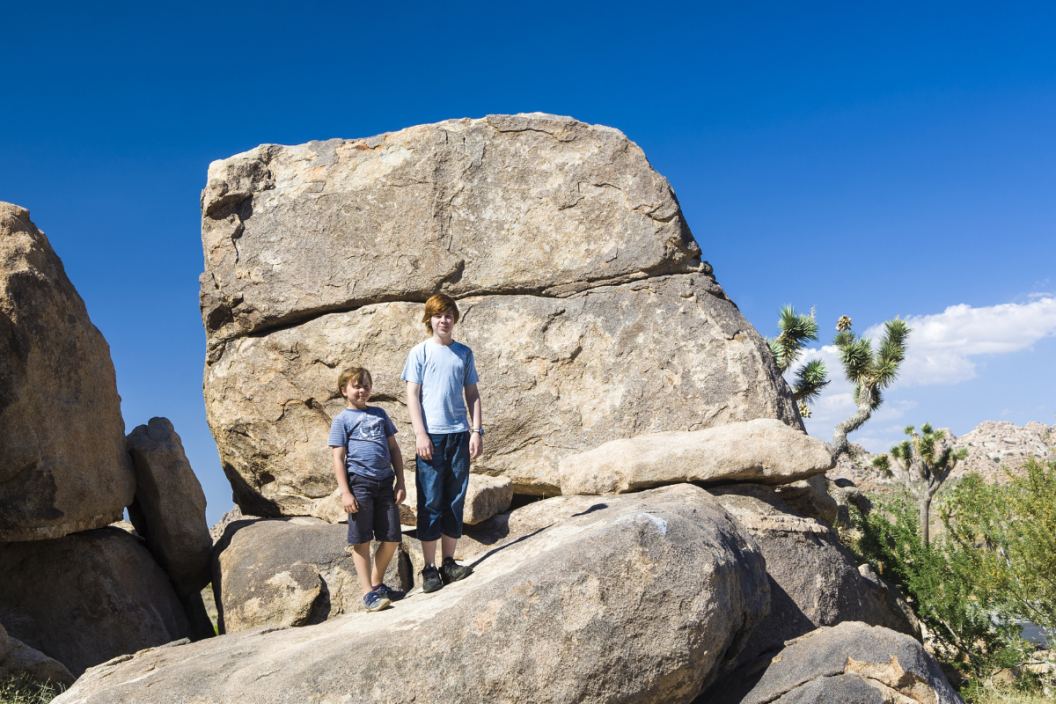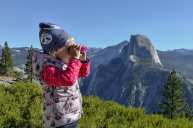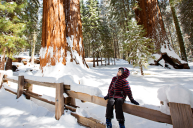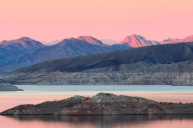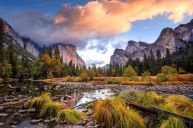Joshua Tree National Park sprawls out east of Palm Springs and the Coachella Valley area; you might remember from your days going to music festivals in the middle of the desert. Now that you're adulting and have kids to raise all proper-like, wandering Southern California for rock climbing spots and concerts isn't going to cut it.
Let's face it: The kids aren't great climbers, and there aren't any bighorn sheep in the area who will volunteer to babysit for you.
But just because you traded in your favorite ripped-up t-shirt and wineskin for sunscreen and lots of water, it doesn't mean your adventures are over. Taking young hikers into the incredible American wilderness is just the beginning of a whole new chapter. The National Park Service is the perfect partner to help make it happen. After all, you might as well put those tax dollars to work, right?
Like many national parks, Joshua Tree is an excellent destination for families with kids of all ages. Joshua Tree is a great place to introduce children to the wonder of American deserts. The park has nature trails surrounded by wildflowers and petroglyphs and hikes with jumbo rock formations that'll make your kids' little heads spin,
Since we know you're busier than ever looking into family cell phone plans and hunting down Amazon deals on school supplies, we've created the following guide to make your trip to the park that much easier!
How to Enjoy Joshua Tree National Park With Kids
Joshua Tree National Park and Junior Ranger Badges
https://www.instagram.com/p/COD92MJhaTj/
Fortunately for parents, park rangers love young kids and are happy to help get them stoked on national parks. The NPS's Junior Ranger Program was created with this sentiment in mind, making it a great way to engage children with fun activities. You can find junior Ranger activity books at any of the park's visitor centers.
Once they're completed, kids can turn them in to receive Junior Ranger Badge and be sworn in as honorary park rangers.
Park Entrances and Areas
https://www.instagram.com/p/CJ61nKMAU2h/
RELATED: What Are California's Cabazon Dinosaurs Doing There?
Joshua has many park entrances, and you'll probably want to plan your trip according to which route you plan on taking. The following info will give you a good idea of how to take in the park whether you're just driving through or making an extended round trip.
- North Entrance: This is the best way to enter the park if you're coming in from Nevada or northwest Arizona. From here, you can easily reach sites kids love like Skull Rock, Arch Rocks, and Jumbo Rocks, not to mention the Jumbo Rocks Campground. This is also the fastest route to the famous Cholla Cactus Garden. In addition, some of the park's best hikes, like the Barker Dam Trail, can be reached by way of this entrance.
- West Entrance: If you're taking Highway 247 from the region north of Los Angeles, either this entrance or the nearby Black Rock Entrance is your best bet. The West Entrance is the easiest way to get to the bulk of the park's central attractions, including family-friendly sites such as Keys Ranch and Hidden Valley. In addition, there are quite a few easy hikes and loop trails to choose from in this part of the park, and it's the most direct way to drive to the beloved Keys Views.
- South Entrance: For those coming up from San Diego or over from Phoenix, this is often the preferred way in. While this entrance unloads right onto the Cottonwood Visitor Center area, there's less going on in this corner of the park in general. As such, some say it's the best option for enjoying the night sky and stargazing. But, more importantly, if you drive a little north of this entrance, you'll come to the place where the Mojave Desert and the Colorado Desert combine to create a breathtaking landscape full of rare and vibrant biomes.
- Indian Cove Entrance: Visitors can access the Indian Cove area by Highway 62 between the West and North entrances. Its inroad doesn't link up with the rest of the park, but you should pop in if you're shuttling between West and North.
Fun Facilities
https://www.instagram.com/p/BU6VhmzANSi/
Kids love to explore everything, regardless of what boring adults consider interesting. This being the case, it's a good idea to stop by as many park facilities as possible to feed their hungry little minds. Artificial destinations you should consider visiting include the following options:
- Oasis Visitor Center: The Oasis Visitor Center is technically located in Twentynine Palms near the North Entrance. It has picnic tables, a bookstore, and exciting exhibits.
- Joshua Tree Visitor Center: In addition to a bookstore, exhibits, and a cafe, the park's main visitor center has a public telephone and nearby showers for overnighters who need to freshen up. It's right off the 62 ahead of the West Entrance.
- Cottonwood Visitor Center: Located in Cottonwood Spring, this site has a picnic area, water, and as ever, exhibits that'll spark kids' interest. Take the South Entrance from I-10 to reach it.
- Black Rock Nature Center: More of a museum than a visitor center; you can find this nature center in Yucca Valley. It's not far from the 62 in the northwest corner of the park.
Camping in Joshua Tree National Park
https://www.instagram.com/p/CMyHxp7HFbY/
There are quite a few campgrounds spread out across the park, and each one is as good for kids as the next. However, considering how busy the park gets, you'll want to be sure to make reservations well in advance. Of course, there are always Airbnb's and other options if the park is full or the weather's getting too hot.
What is the Best Time to Visit Joshua Tree National Park
https://www.instagram.com/p/CI1ELLxjP2i/
Picking the best time to visit Joshua Tree is always challenging due to extreme heat during the summer months and rampant tourism during the cooler seasons. Planning a kid-friendly day-trip or weekend getaway complicates things, but that doesn't mean you can't still have an excellent trip.
Any tips and tricks for families visiting Joshua Tree National Park? Share the family love on our Wide Open Roads Facebook!
